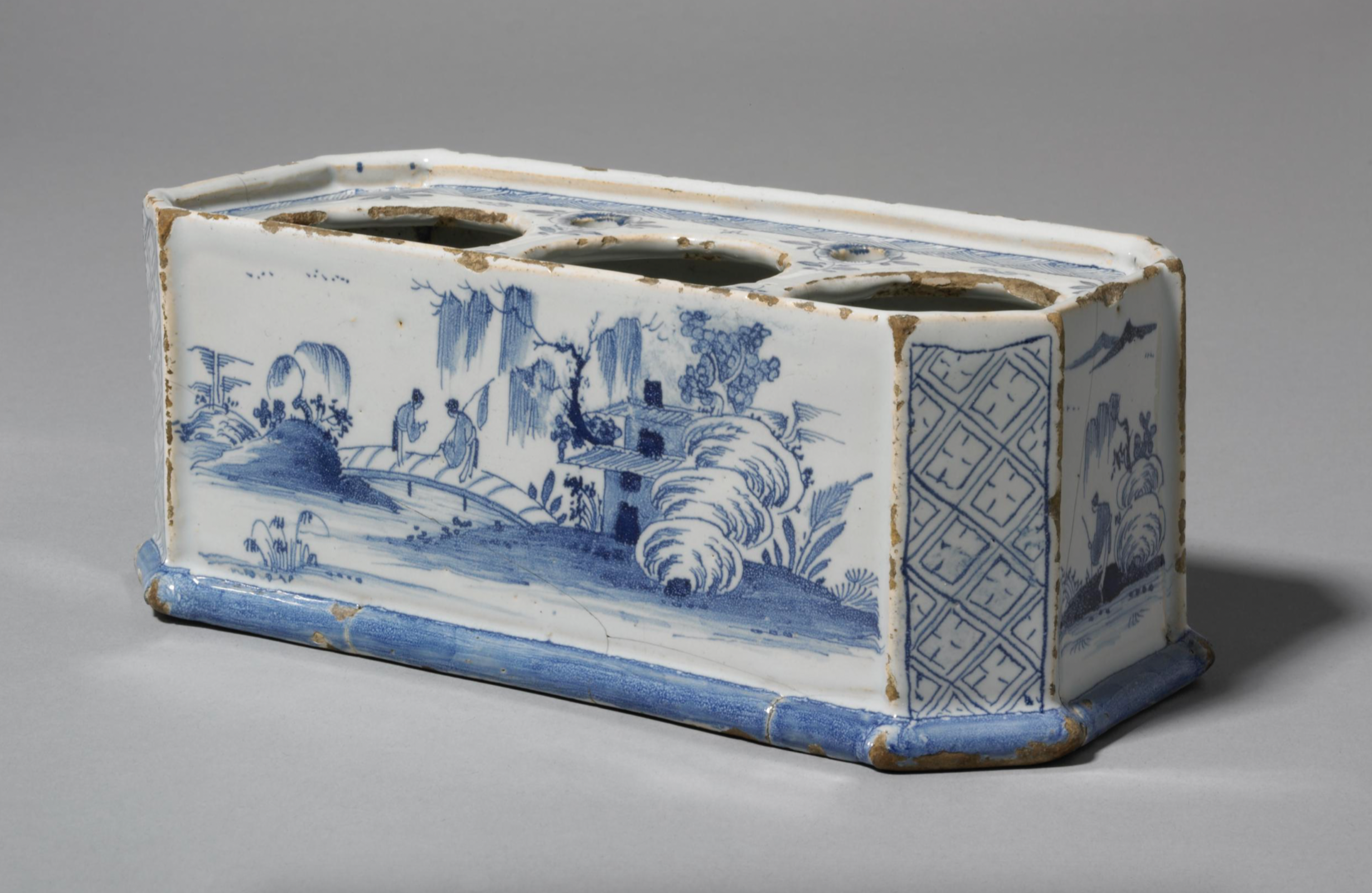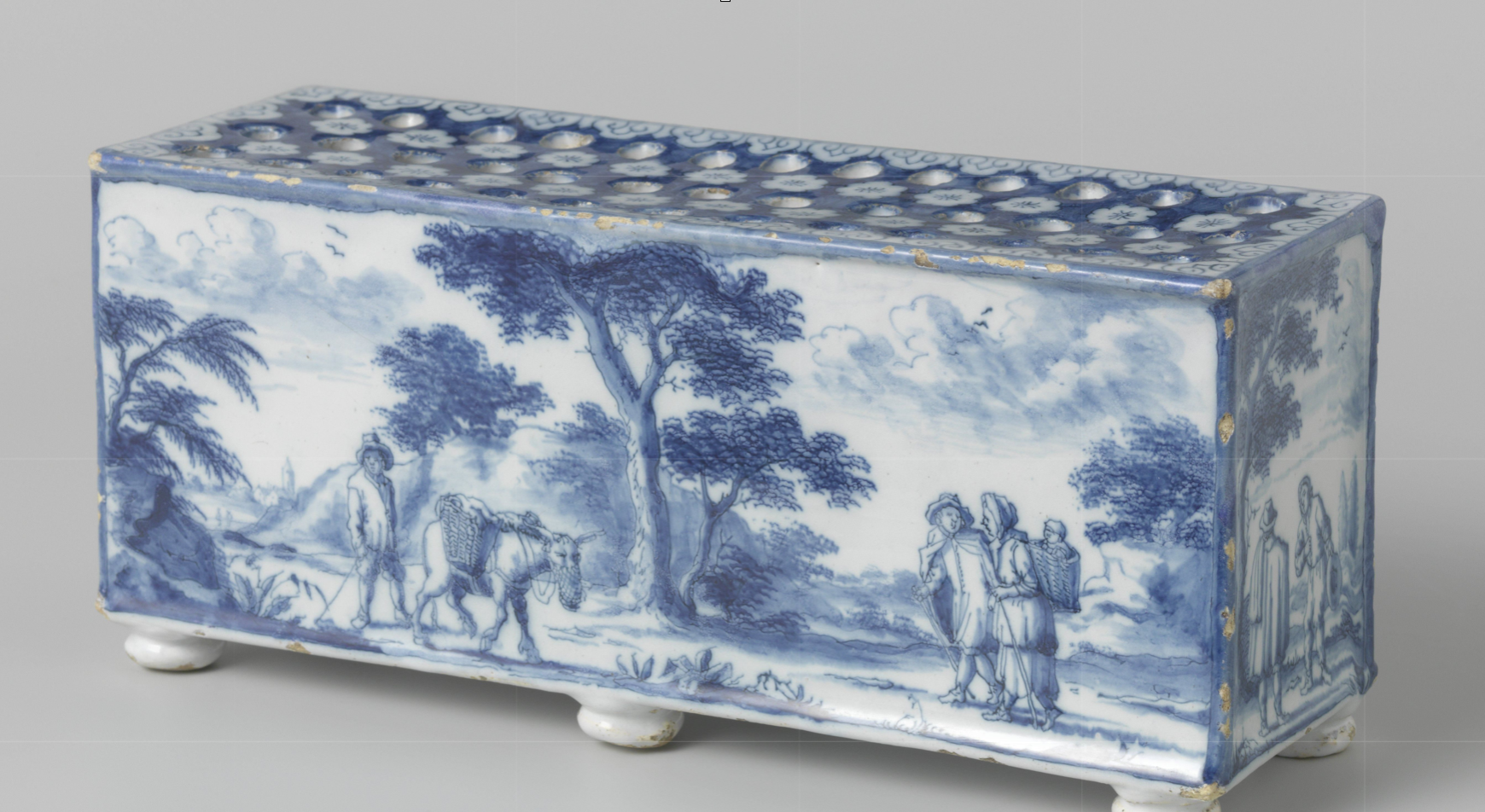
English Delftware
Delftware is a popular term applied not only to tin-glazed earthenware made in the city of Delft, but in many other production centers within the Netherlands and beyond, especially in England. Starting in the early seventeenth century, English earthenware was called ‘Galleyware,’ later ‘White Ware’ and subsequently known as Delft or more common ‘English Delftware’. (1)
The use of tin-glaze on earthenware was not actually invented in Delft, or even in the Netherlands. It originated in the Middle East and then spread throughout Southern Europe beginning in the thirteenth century. The technique further developed in Italy, from where it was brought to The Low Countries later in time. The English were introduced to tin-glazed earthenware by Italian majolica imports as well. In 1508 or possibly earlier, Guido di Savino, also known as Guido Andries introduced the technique in Antwerp. Guido’s son, Jasper and a fellow Antwerp citizen called Jacob Jansen, fled from Antwerp to escape religious persecution and settled in Norwich in 1567. In fact, Jasper’s brother Joris also left Antwerp and settled in Middelburg, where he played an important role in the development of the Dutch pottery industry. In Norwich, Jasper and Jacob tried unsuccessfully to patent the production of tin-glazed earthenware. Jansen then went to London, where he produced tin-glazed earthenware with a group of other Flemish potters. Many other factory owners followed, and they all settled near the River Thames. Factories also emerged outside of London. (2)
Queen Mary, the wife of William of Orange, was a passionate collector of Delftware. She first became attracted to the blue and white objects when the Royal couple lived in Holland. Back in England, Queen Mary continued to patronize the Delftware industry by ordering many special pieces from De Grieksche A (The Greek A) factory. (3) The English court and nobility were inspired by Queen Mary’s collection of Delftware and they soon adopted similar taste, further spreading the style.
Initially, English potters mainly copied other styles, but they eventually adapted a style of their own. (4) They were first inspired by polychrome majolica from Antwerp, and then Chinese porcelain once tastes across Europe shifted during the seventeenth century. Christian Wilhelm, the owner of the Pickleherring Pottery in London was the first to apply Chinese decoration on English Delftware in 1628. Wilhelm, and after his death in 1630, his son, were granted the monopoly to do so for fourteen years.

There are many similarities between English and Dutch Delftware. Sometimes, the place of origin is indistinguishable for objects made before the middle of the seventeenth century. For example, the clay used in Norfolk and Suffolk was exported to the Netherlands and was used in Delft as well. Further, pottery painters from the Netherlands also worked in England and vice versa, which can make it very difficult to identify objects. (5) Despite the similarities, some differences occur. In Delft, objects were given a second layer of transparent lead glaze, named ‘kwaart’, which the English rarely applied. The eighteenth century custom to mark pottery in Delft was not common on English Delftware. (6) Also, the quality of English Delftware does not meet the high standards of Delft, where pottery painters were controlled by the Guild of St Luke, which required a high level of quality. (7)
This might be the reason that, although Delftware was produced in England itself, there was still import from the Netherlands. In 1676, English potters petitioned the King to ask for a ban of Dutch Delftware. This fact makes it plausible that Dutch Delftware arrived in such large quantities that it was disturbing the domestic production. The petition was successful, because in 1684, Dutch potters requested to lift the import ban. However, English potters continued to request import bans in 1685, 1689, 1690 and 1694. (8) The embargo officially lasted until 1775, when the production of Delftware was only minor, due to the rise of other ceramics of which Wedgwood was the most important. King William and Queen Mary were not affected by the embargo and ordered many impressive pieces of Delftware from the Netherlands during their reign.

As an example of the difference in quality, we show a comparison between a flower-brick in the collection of the British Museum in London with one by De Grieksche A in the collection of the Rijksmuseum in Amsterdam. The difference in style is seen in the more spontaneous and less refined English object, against the serious and delicate Dutch Delft example. (9)
The popularity of Delftware in England was not entirely evident. The production process was complicated and the risk of failure during the firing process was high. Less than half of the products left the kilns completely as desired, without any damage. This made it an expensive business. Further, because Delftware cannot withstand hot liquids, the objects were not suitable for teacups and England was a tea-drinking nation in the eighteenth century. This alone could have spelled the end for Delft pottery in England. Nonetheless, the clean and bright appearance made it a very popular decorative object, especially for commemorative purposes as the clear white surface is utmost suitable for inscriptions. (10)
The success of English creamware from North Staffordshire and the production of porcelain meant the heyday for English and Dutch Delftware was over. The pottery makers in Staffordshire were able to make a stronger and whiter product. They even introduced industrial techniques that disadvantaged Delft potters in both countries. Only ‘De Porceleyne Fles’ in Delft managed to survive the shifting marketplace. English production stopped, as most manufacturers switched to creamware or porcelain, or simply ran out of business.
(1) Aileen Dawson, English & Irish delftware 1570-1840, The British Museum Press, 2010, p. 9
(2) Dawson, p. 9-10
(3) Aronson.com, A Passion and a Fashion; Queen Mary II’s Delftware at Hampton Court Palace
(4) Anthony Ray, English Delftware, Oxford, 2000, p. 6
(5) Michael Archer, English Delftware, Amsterdam, 1973, p. 6
(6) Archer, p. 9
(7) Ray, p. 7
(8) Archer, p. 7
(9) Archer, p. 28-29
(10) Ray, p. 5



